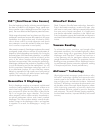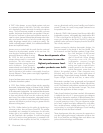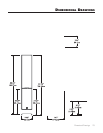
How do I clean my speakers?
Use a dust free cloth or a soft brush to remove the dust
from your speakers. We also recommend a specialty
cloth (available at the Xtatic shop at www.martinlogan.
com) that cleans your speakers better than anything else
we have tried. For the wood surfaces it is acceptable to
slightly dampen the cloth. Do not spray any kind
of cleaning agent on or in close proximity
to the electrostatic element. Avoid the use of
ammonia based products or silicone oil on
the wood parts.
What is the advantage of ESL?
Since the diaphragm is uniformly driven over its entire
surface—unlike a tweeter that is only driven at its
edges— it is the only technology that can be made
large enough to play bass, yet is still light enough for
high frequencies. This unique property allows for the
elimination of high frequency crossover points and their
associated distortions.
Could you suggest a list of suitable elec-
tronics and cables that would be ideal for
MartinLogan speakers?
The area of electronics and cable choice is probably
the most common type of question that we receive. It
is also the most subjective. We have repeatedly found
that brands that work well in one setup will drive some-
one else nuts in another. We use many brands with
great success. Again, we have no favorites; we use
electronics and cables quite interchangeably. We
would suggest listening to a number of brands—and
above all else— trust your ears. Dealers are always the
best source for information when purchasing additional
audio equipment.
Why does my speaker make popping noises
and hums?
The Purity features a built in muting circuit that will
detect popping anomalies and minimize them.
When using the speaker level inputs a popping noise
may occur when the amplifier is turned on or off. This is
caused by grounding interaction between the speaker
and the amplifier. It is normal and to be expected.
When making or breaking connections from devices that
utilize the Line Level input a popping noise may occur.
This is caused by grounding and static discharge inter-
action. It is normal and to be expected when using this
method of connection. If a cable is connected to the
speaker, but is left unterminated at the device end you
may also experience a low-level hum. To minimize these
intermittent noises we recommend using a device that is
permanently connected (such as a digital music player
docking station).
Is there likely to be any interaction between my
speakers and the television in my Audio/Video
system?
Actually, there is less interaction between a television
and an electrostatic speaker than between a television
and a conventional system. However, we do recommend
that you keep your speakers at least one foot away
from the television because of the dynamic woofer they
employ.
Will my electric bill go ‘sky high’ by leaving my
speakers plugged in all the time?
No. A pair of MartinLogan’s will draw about 8 watts
maximum (idle). There is circuitry to turn off the static
charge when not in use; however, actual consumption
will remain close to the same. The primary purpose of
the sensing circuitry is to prevent dust collection on the
electrostatic element.
If the diaphragm is punctured with a pencil or
similar item, how extensive would the damage
to the speaker be?
Our research department has literally punctured hundreds
of holes in a diaphragm, neither affecting the quality of
the sound nor causing the diaphragm to rip. However,
you will be able to see the actual puncture and it can
be a physical nuisance. If this is the case, replacing the
electrostatic transducer will be the only solution.
Will exposure to sunlight affect the life or per-
formance of my speakers?
We recommend that you not place any loudspeaker
in direct sunlight. The ultraviolet (UV) rays from the sun
can cause deterioration of grill cloth, speaker cones,
etc. Small exposures to UV will not cause a problem.
In general, the filtering of UV rays through glass will
greatly reduce the negative effects on the electrostatic
membrane itself.
Frequently Asked Questions 19
FREQUENTLY ASKED QUESTIONS


















